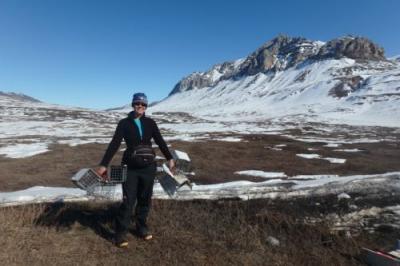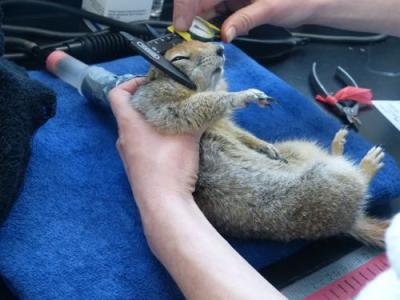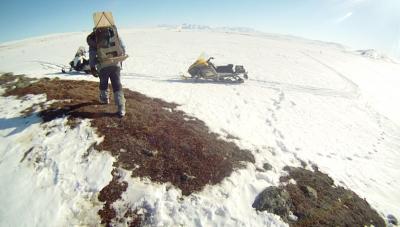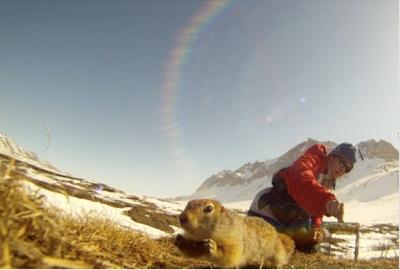Why should a teacher go on a science expedition?
Music teachers often play instruments in local orchestras. PE teachers are often involved in sports outside of school. Art teachers pursue their medium and drama teachers act in local performances. Science teachers talk about science, but we very rarely get an opportunity to do basic research.
When I was a graduate student, I loved being in the field and doing research. As a science teacher, I talk about science all day, but I haven’t done any myself in years. Teaching is such a busy job that there is often not enough time to learn about all of the new science techniques and findings that have been happening. 
When I first heard about PolarTREC, I knew that this was the type of experience that would help me get back out there and get involved in science that is happening now. I applied three times to the program, and this year I was rewarded for my perseverance when I was selected as a participant. The experience was fantastic, and it allowed me to immerse myself in the experience of working in a polar environment. I learned new skills working with a research team on Arctic ground squirrels, and I was able to interact with other researchers to learn what they are doing as well.
How do I plan to link this back to my classroom?
I teach both the Middle Years and Diploma Programs (MYP and DP) in the International Baccalaureate (IB) program, and both have a focus on a student being able to think critically. In science classes, this translates to being able to design, carry out and then analyze and evaluate an experiment. I plan to incorporate the design of the long-term study that we focused on, discussing the design and the method that we followed. I will also get data from the ground squirrel study from my Principal Investigator Cory Williams for my students to use. They will be able to analyze and interpret the data. They can also use it to generate new hypotheses and brainstorm experiments that would allow them to test their ideas. I would also like to use it to create data-based questions.

I will also incorporate my personal experiences in the Arctic with the larger picture of ecology and climate change, which fits into the syllabus for the courses I teach at different levels. I will be able to use new food chains and food webs with my biology classes. I will have new examples to use when we learn about adaptations. The ground squirrel project also bridges different scientific disciplines, as they are measuring the neurobiological and physiological response of Arctic ground squirrels to changes in the weather, which are driven by climate change. The physiological response of the squirrels, in turn, influences the ecology of the species. This gives me a lot of possibilities to use this research in different ways. I would also like to explain and encourage the value of basic research, where the goal is not to create knowledge that is of immediate direct benefit to humans, but is instead to generate knowledge which will benefit human kind in unpredictable ways that are not immediately tangible.
List 3-5 things you expected to learn during your experience. Did you succeed? Why or why not?
1. The role of Arctic ground squirrels in their ecosystem
Arctic ground squirrels can have direct effects on their habitat, through foraging, and perhaps more importantly, by creating burrow systems. This impact is dictated to a large degree by the soil type. Where the soil is more porous and sandy, the burrows are not as long-lasting is the environment, for example. Further, Arctic ground squirrels are important prey items for a variety of predators, including foxes, wolves, and golden-eagles. While there, I didn’t observe any predation events. 
2. Why are scientists studying timing in ground squirrels?
I learned that like many seasonal animals, Arctic ground squirrels go through puberty every year. But ground squirrels go through puberty without exposure to the usual signal, increasing daylight, that tells others summer is coming. They miss this signal because they are below ground in hibernacula. Because of this, scientists can examine the molecular changes that occur during a precisely timed puberty, independent of changing photoperiod. They can also see how the timing of puberty is changed in response to temperature changes, which are expected under climate change. By studying this, they hope to better understand the mechanism that allows animals to be flexible in response to environmental change.
3. How to work safely with ground squirrels
Nearly all of our time in the field was spent looking for, trapping or working with the squirrels directly. I learned how to keep myself and the squirrels safe. Once trapped, we took the squirrels back to the lab for processing. When under anesthesia, the squirrels aren’t able to control their body temperatures as well, so it would be too cold to work with them outside. Instead, we brought them in, and once anesthetized, we kept them on a heated blanket while we worked with them to help them stay warm. I learned how to anesthetize the squirrels so that they would be clean and comfortable, and how to measure, ear tag and record data about them. All of the animals were well cared for while they were in captivity overnight, and they were released the following day directly to the burrow where they had been captured.
4. How to drive a snowmachine and layer well
As someone who grew up in Florida, and now lives in a relatively mild climate, I wanted to gain a better understanding of how to survive in the changing climate in the Arctic spring. I was provided with a lot of outerwear but was not exactly sure what to wear when, or which things I could layer with which. After asking the right questions, I was pleasantly surprised by the outcome, finding that most days I could get by with long underwear and a thin waterproof layer. On colder days, a pair of fleece pants worked well as a middle layer. On one occasion I had the opportunity to accompany another research team into the field, and this required a ten mile snowmachine ride in the cold morning hours. I did not think I had enough gear to keep me properly insulated, but everyone came to my rescue, loaning me boots and bibs and neck gaiters to stay extra warm. I appreciated their willingness to help, but also the different pieces of gear and again, what I could wear to stay warm. It gave me a new sense of how animals can stay warm in such a climate. It’s all about the insulation. 
I also wanted to learn how to drive a snowmachine, as I have never had the experience of being on one before. This did not go as well as expected. I found myself much more uncomfortable on the machines than I thought I would. I was afraid to flip the machine, and some turns seemed like this would be inevitable, though I never did flip one. In the end, I did not get as much practice as I’d expected both because we were not working at the site that required snowmachine use as often, and we worked there mostly as it started to warm, so the snow was melting and it was even harder to drive the snowmachines. For the most part, I let my PI do the driving at this time, which gave me a little less field time at the Toolik site.
5. How data processing is done when so much data is constantly collected (ex. Body temps taken every minute for months.)
The majority of our time was spent in the field, trapping squirrels, or in the lab, processing squirrels. We were outside as soon as it was warm enough for the squirrels to be active above ground, and we stayed in the field as long as we were catching new squirrels. We processed most squirrels in the evenings, including taking morphometric data and downloading light collars. There was not much time for data processing while we were there. This makes sense, as you need to maximize your time in the field to collect as much data as possible while you are there. Data analysis can be done away from the field site, so it will be processed at a later date.
List 3-5 concepts that you’d like to teach better or differently. How does this impact your students?**
1. Critical thinking
This is a skill that everyone needs, whether it is science-related or not. Today, students have so much information at their fingertips, but they have to learn how to determine if a site is a trustworthy source. They also have to be able to interpret and analyze the information they uncover. Is it correct? Is it verifiable? Is the source reliable?
2. Climate science
This is a topic that is very talked about these days, but not always in the ways expected. Many students have heard about climate change and think they know everything, but when questioned, they do not know the facts. For example, climate change is occurring more rapidly in the Arctic, but it is not constant across the Arctic. For example, a couple hundred miles north of Toolik, directly adjacent to the Arctic ocean, the effects of climate change are very obvious due to thinner sea ice and earlier ice melt. But at Toolik, the impact is not as large. 
I would like to incorporate my experience in the Arctic, and the experience of other PolarTREC teachers, into my lessons about climate change to bring a personal element into the story. I think if students feel invested in some way, even by association, it will make the conversation more genuine and more immediate.
3. Long term interpretations of how we treat the earth
This is another topic that students have heard about since they were small, and it is crucially important and yet easily dismissed by students at the same time. “Yeah, yeah, we know.” I would like to find a way to impress upon them the beauty and importance of the natural world in a way that makes them think about, and possibly create solutions to, how we are treating our resources, where they come from and how we obtain them. Many of my students have been impressed with my field site location, how beautiful it was, and how pristine it looks. And yet in most photos, the oil pipeline is a prevalent feature. Good discussions have already started to come out of these pictures, and I would like to keep them going.
Are there activities that you will pursue that the public should know about?

Other ideas on how I’ll share this experience with the public and my peers
I am scheduled to give a talk at the IB conference in The Hague in October, in order to share my experience as a teacher-researcher with other likeminded teachers, to encourage them to apply or find other, related programs where they can gain current research experience. I also hope to attend and be part of the PolarTREC group at the Polar 2018 conference in Davos next year.
My school is eager to host one of the squirrel researchers, Helen Chmura, to speak to our students of her experiences as a scientist. We hope to do this as part of our In Dialogue speaker series. Our school library is also putting together a selection of Arctic books to encourage our students to read about the environment.
I am also searching out venues to speak at to inform others of the expedition, and to give them insight into polar research. Possible locations include the zoo, natural history museum and local bookstores.
| Attachment | Size |
|---|---|
| Download Report (1.35 MB)1.35 MB | 1.35 MB |
This program is supported by the National Science Foundation. Any opinions, findings, and conclusions or recommendations expressed by this program are those of the PIs and coordinating team, and do not necessarily reflect the views of the National Science Foundation.
